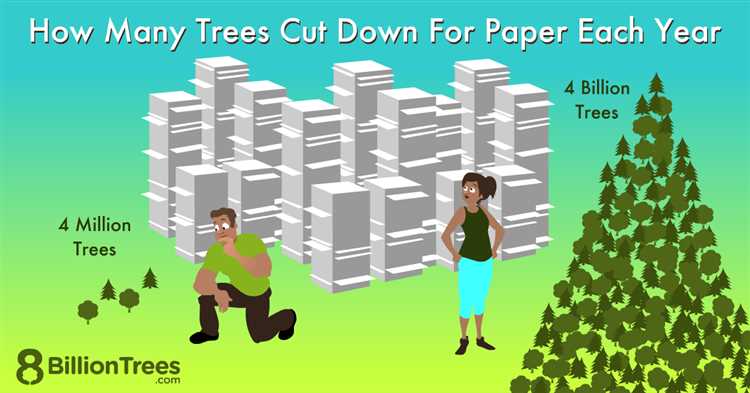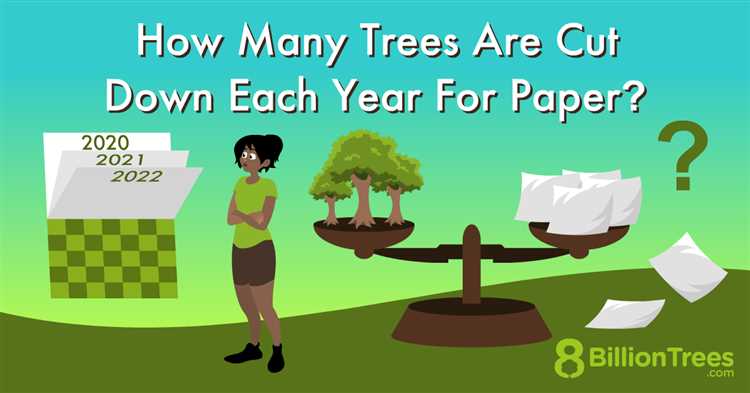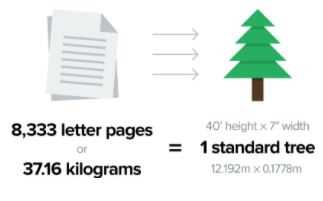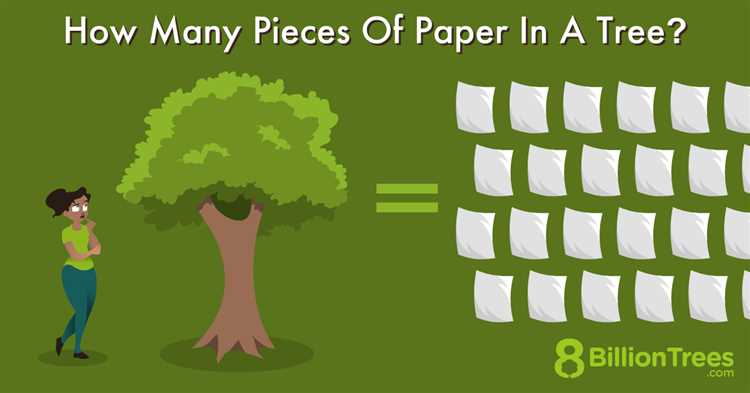
When we think about everyday objects that are made from trees, paper is one of the first things that comes to mind. From books and newspapers to writing pads and packaging materials, paper is an essential part of our daily lives. But have you ever wondered how much paper can be produced from a single tree? The answer may surprise you.
On average, one tree can produce about 8,333 sheets of paper. However, this number can vary depending on the size and type of tree, as well as the production process. Some trees, like the eucalyptus, are particularly efficient at producing paper due to their high fiber content.
It’s also worth noting that not all parts of a tree can be used for paper production. Only the wood fibers from the trunk and branches are suitable for making paper. Leaves, roots, and bark are typically discarded during the production process.
But how much does a stack of 8,333 sheets of paper weigh? The weight of a sheet of paper can vary depending on its thickness, but on average, a single sheet weighs about 0.016 kg. So, if we do the math, one tree can produce approximately 133 kg of paper.
While this may seem like a significant amount, it’s important to remember that paper production has a significant impact on our forests. According to the Environmental Paper Network, around 40% of global industrial logging goes into making paper. This puts a strain on our forests, which are vital for the health of our planet.
So next time you pick up a piece of paper, remember that it comes from a tree. Each sheet represents a small portion of a tree’s life and the impact it has on our environment. By being mindful of our paper usage and supporting sustainable forestry practices, we can help conserve our forests for future generations.
- Exploring Paper Production from Trees
- Understanding the Process
- The Impact on Forests
- 1. Deforestation
- 2. Loss of Wildlife
- 3. Soil Erosion
- 4. Water Conservation
- Calculating Paper Output
- Determining the Age and Size of the Tree
- Identifying the Type of Tree
- Calculating Paper Output
- Factors Affecting Paper Yield
- Sustainable Alternatives
- Question-answer:,
- How much paper can one tree produce?
- Is it sustainable to produce paper from trees?
- How many trees are cut down to make paper each year?
- What are the alternatives to using trees for paper production?
Exploring Paper Production from Trees
Paper is one of the most widely used materials in everyday life. From newspapers to books, packaging to stationery, paper plays a crucial role in our society. Have you ever wondered how paper is made from trees?
Before delving into the process of paper production, it’s important to understand the significance of trees in this cycle. Trees are renewable resources that provide the primary raw material for paper production. They absorb carbon dioxide, release oxygen, and contribute to maintaining a healthy ecosystem.
In the paper production process, trees are first harvested and transported to a paper mill. Once at the mill, the trees go through several steps to become the paper we use. These steps include debarking, chipping, pulping, screening, cleaning, refining, and drying.
The debarking process removes the outer layer of the tree, while chipping breaks the tree into small pieces. Pulping involves separating the wood fibers from the other components of the tree, such as lignin, hemicellulose, and extractives. The wood fibers are then screened to remove impurities and cleaned thoroughly.
Refining is the process of further reducing the size of the fibers to enhance the paper’s strength and appearance. Finally, the fibers are dried to remove excess moisture and form the basis for the paper.
Once the fibers are ready, they are mixed with water to create a pulp. This pulp is then pressed and dried to form sheets of paper. The dried sheets are processed further to achieve desired characteristics, such as smoothness, thickness, and durability.
It is estimated that one tree can produce approximately 8,333 sheets of copy paper, weighing around 18 kilograms. However, it’s important to note that the actual amount of paper produced from a tree can vary depending on factors such as tree species, size, and the paper production process employed.
As society becomes more environmentally conscious, efforts are being made to increase paper recycling and reduce the overall demand for paper. Recycling paper helps conserve natural resources, reduces landfill waste, and minimizes the negative impact of paper production on the environment.
In conclusion, paper production from trees goes through a complex process involving harvesting, pulping, refining, and drying. While one tree can produce a significant amount of paper, it’s vital to remember the importance of sustainable practices and recycling to minimize the environmental impact of paper production.
Understanding the Process
Before we delve into the topic of how much paper one tree can produce, it’s important to understand the process involved in paper production. Paper is made from cellulose fibers, which can be obtained from various sources like wood, cotton, or recycled paper.
The process begins with the harvesting of trees, particularly those that are grown in sustainable forests. These trees are then cut into logs and sent to a pulp mill where they undergo the pulping process. This process involves breaking down the wood into small fibers to extract the cellulose.
Once the cellulose fibers are extracted, they are then mixed with water to create a pulp mixture. This mixture goes through a series of cleaning and refining processes to remove impurities and improve the quality of the pulp. Chemicals like bleach may also be used to enhance the brightness and whiteness of the pulp.
After the pulp is refined and cleaned, it is then formed into paper through a process called papermaking. The pulp mixture is spread onto a moving screen or wire mesh where the water drains out, leaving behind a mat of fibers. This mat is then pressed and dried to remove any remaining water content.
Depending on the desired paper quality, the dried mat may go through additional processes like coating, calendering, or sizing. These processes help to improve the smoothness, gloss, and printability of the paper.
Once the paper is ready, it is cut into different sizes and packaged for distribution. The entire process of paper production requires careful resource management, including the use of efficient machinery and recycling systems to minimize waste and environmental impact.
Understanding the paper production process is crucial in evaluating the environmental impact and determining the amount of paper that can be produced from a single tree. By considering factors like tree species, size, and pulp yield, we can estimate the average amount of paper that can be obtained from a specific tree.
The Impact on Forests

The production of paper has a significant impact on forests around the world. The demand for paper has led to widespread deforestation, causing major environmental concerns. Here are a few key points to consider:
1. Deforestation

One of the main consequences of paper production is deforestation. Trees are cut down at alarming rates to meet the growing demand for paper products. This leads to the destruction of natural habitats and loss of biodiversity. Deforestation also contributes to climate change by reducing the number of trees that absorb carbon dioxide.
2. Loss of Wildlife
As forests are cleared for paper production, countless species of plants and animals lose their homes. Many of these species are unique and cannot be found anywhere else in the world. The loss of habitat often leads to the extinction or endangerment of certain species, disrupting the delicate balance of ecosystems.
3. Soil Erosion
Without trees to anchor the soil, the land becomes vulnerable to erosion. Forests play a crucial role in preventing soil erosion by absorbing rainwater and holding it in their roots. When trees are removed, the soil becomes easily washed away by rain, causing sedimentation in nearby rivers and streams. This not only affects the quality of the water but also harms aquatic life.
4. Water Conservation

Forests are essential for water conservation. They act as natural filters, capturing rainfall and replenishing underground water sources. Without trees, water resources become depleted, leading to water scarcity in many regions. This can have serious consequences for both humans and wildlife that rely on these water sources.
In conclusion, the production of paper has a profound impact on forests and the delicate ecosystems they support. It is crucial that we promote sustainable practices and reduce our reliance on paper to protect these valuable natural resources.
Calculating Paper Output

Calculating the paper output of a tree involves several factors that need to be taken into consideration. These factors include the age and size of the tree, the type of tree, and the efficiency of the paper-making process. Let’s break down the steps involved:
Determining the Age and Size of the Tree
The first step in calculating paper output is to determine the age and size of the tree. Mature trees generally yield more paper than younger ones. The age and size of the tree can be determined through various methods such as counting growth rings or measuring trunk diameter.
Identifying the Type of Tree
The type of tree also plays a crucial role in paper production. Different tree species have varying fiber-to-wood ratios, which affect paper output. For example, coniferous trees such as pine and spruce tend to have longer fibers and higher paper yields compared to deciduous trees like maple and oak.
Once the age, size, and tree type have been determined, the next step is to consider the efficiency of the paper-making process. A well-optimized paper-making process can maximize paper output by effectively extracting and refining the fibers from the tree.
It is important to note that not all parts of a tree can be converted into paper. Usually, only the trunk is used, while the branches and leaves are utilized in other industries or discarded. The amount of usable wood from a tree varies depending on the tree species and its overall condition.
Calculating Paper Output
To calculate the paper output of a tree, the following formula can be used:
Paper Output (kg) = Wood Weight (kg) x Pulp Yield (%) x Paper Yield (%)
The wood weight is determined by multiplying the volume of the tree (calculated using the tree’s size) by the density of the wood. The pulp yield represents the percentage of wood that can be converted into pulp, while the paper yield represents the percentage of pulp that can be turned into paper.
This formula provides an estimate of the potential paper output of a tree. However, it is important to remember that these values may vary depending on the specific conditions and processes involved.
In conclusion, calculating the paper output of a tree requires considering various factors such as age, size, tree type, and paper-making efficiency. By understanding these factors and using the appropriate formulas, it is possible to estimate the amount of paper that can be produced from a single tree.
Factors Affecting Paper Yield
Several factors can affect the amount of paper that can be produced from a single tree. These factors include:
- Tree species: Different tree species have varying fiber lengths and properties, which can affect the paper yield. Some species, such as pine and spruce, are commonly used for paper production due to their long and strong fibers.
- Tree age: Older trees typically have thicker trunks and more wood, which means they can yield more paper. However, younger trees often have more flexible fibers, which can result in a higher pulp yield.
- Tree size: The size of the tree, including its height and diameter, can influence the amount of usable fiber it contains. Larger trees tend to have more fiber, resulting in a higher paper yield.
- Growth conditions: The growth conditions of the tree, such as climate, soil quality, and availability of water and nutrients, can affect its overall health and fiber quality. Healthy trees with strong fibers can produce more paper.
- Harvesting technique: The method used to harvest the trees can also impact the paper yield. Selective and sustainable harvesting practices can help ensure that only mature trees are harvested while younger trees are left to grow, maximizing the paper yield over time.
It is important to consider these factors when assessing the environmental impact of paper production and promoting sustainable practices. By understanding how these factors influence paper yield, we can work towards minimizing waste and optimizing resource usage in the paper industry.
Sustainable Alternatives
While the demand for paper continues to rise, it’s important to consider sustainable alternatives to reduce the environmental impact. Here are a few alternatives:
| Alternative | Description |
|---|---|
| Recycled Paper | Using paper made from recycled materials significantly reduces the need for new trees to be cut down. It helps to conserve natural resources and minimizes waste. |
| Tree-Free Paper | Tree-free paper is made from alternative fibers like hemp, bamboo, or straw. These fibers are fast-growing and can be easily replenished, making them a more sustainable option. |
| Digitalization | Shifting towards digital platforms and technologies can greatly reduce the need for physical paper. With the advancement of technology, digital documents and communication have become more efficient and convenient. |
| Reducing Paper Usage | Implementing strategies to reduce paper usage, such as double-sided printing, using electronic invoices and receipts, and encouraging paperless workflows, can make a significant impact. |
| Efficient Recycling Systems | Investing in proper recycling systems and infrastructure helps ensure that the paper waste generated is effectively recycled and used to produce new paper products. |
By adopting these sustainable alternatives, we can reduce our reliance on traditional paper production methods and contribute to a greener and more sustainable future.
Question-answer:,
How much paper can one tree produce?
One tree can produce approximately 100 pounds (45 kilograms) of paper.
Is it sustainable to produce paper from trees?
While paper production does require cutting down trees, it can be sustainable if proper forest management and tree replanting practices are implemented. Additionally, recycling paper can help reduce the demand for new trees.
How many trees are cut down to make paper each year?
The exact number of trees cut down for paper production each year varies, but it is estimated that around 3 to 6 billion trees are cut down annually for various purposes, including paper production.
What are the alternatives to using trees for paper production?
There are several alternatives to using trees for paper production, such as using agricultural residues like wheat straw or bamboo. Recycling paper and using alternative fibers like hemp or kenaf can also reduce the reliance on trees.